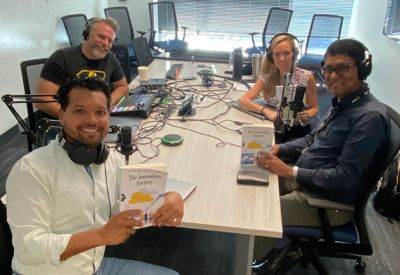-
United States -
United Kingdom -
India -
France -
Deutschland -
Italia -
日本 -
대한민국 -
中国 -
台灣
-
-
產品系列
查看所有產品Ansys致力於為當今的學生打下成功的基礎,通過向學生提供免費的模擬工程軟體。
-
ANSYS BLOG
October 12, 2022
“Hover Cars and Hard Problems” Clocks in at the Innovation Factory with Ansys CTO Prith Banerjee
When he’s not leading the future product direction of Ansys — including exciting developments like the incorporation of artificial intelligence and machine learning — Ansys CTO Prith Banerjee likes to ponder the concept of innovation. In fact, he recently wrote a book on the subject, “The Innovation Factory,” that considers key questions like: “What are the obstacles to true innovation?” and “How can the typical business make innovation an ongoing process?”
Few people are more qualified to discuss this topic. Prith has experienced firsthand the challenges of institutionalizing innovation over the course of his entire career — which includes working as a professor, chairman, and dean at the University of Illinois and Northwestern University, founding two startup companies, directing both HP Labs and Accenture Labs, and acting as the CTO of three companies, including Ansys.
While I’m not here to reveal all the important lessons from “The Innovation Factory” (I instead encourage you to read it yourself), these diverse roles and perspectives have certainly influenced Prith’s views on encouraging innovation. He firmly believes that partnership and collaboration are key elements of creating and successfully sustaining an “innovation factory” that regularly produces game-changing new product and service ideas.
As he writes in the book, Prith thinks the key is creating a culture of “open innovation in which companies, whether large or small, partner outside their internal operations with universities, startups, and other business partners to develop innovative ideas and subsequently deliver them.”

In his role at Ansys, we’ve all seen Prith enact this philosophy daily, as he encourages his team to actively partner with leading universities, research labs, and customer teams to drive the development of new software features and functionality, as well as entirely new product and service platforms that reinforce Ansys’ simulation leadership.
Yet Prith also notes that, even in a culture of collaboration, true innovation is rare. “Open innovation with academia and start-ups, the focal point of this book, is not new,” he points out. “Unfortunately, many of these collaborations do not result in true innovation. My book explores the ingredients of the secret sauce required to generate successful open innovation.”
Listen and Learn: What’s the Secret Sauce Behind Innovation?
While he’s incredibly busy with his leadership role at Ansys, Prith recently took the time to record three episodes of the Ansys podcast, “Hovers Cars and Hard Problems,” which focuses on current and future engineering challenges.
As one of the podcast hosts, I was delighted to welcome Prith into the studio todiscuss some wide-ranging topics including, but not limited to, innovation. Of course, the central question we all want to pose to Prith is: So, what exactly is the secret sauce behind successful innovation? But we explored a lot of other important subjects on the way to that question.
In our first episode with Prith — “Unlocking the Innovation Factory” — he sat down with myself and my co-hosts, Josh Poley and Mary Kate Joyce, to talk about the fundamental idea of innovation: What does it actually mean? Is the term used too loosely? Prith shared an important qualifier: In order to be truly innovative, a new product or service needs to solve a problem and add value. Prith also discussed the difficult, disciplined process of writing, the authors who inspire him, and a modern innovation that he believes will be truly transformative: quantum computing.
Our second podcast episode with Prith, “Unleashing Innovation: The Case for Academia in Innovation” focused on his background in academia and some of the incredible innovations — including mRNA vaccine technologies — that have come from decades of university research and investment. Prith talked about how to form successful partnerships with academic institutions, as well as how universities are changing the ways in which they encourage, measure, and reward faculty innovations.
In “Uniting Innovators: Success Through Stakeholders:” our third podcast of the series, Prith touched on some of the “secret sauce” ingredients, including a focus on sustainable innovation versus disruptive innovation. Another critical ingredient? Creating a specialized team that focuses on innovation, instead of adding the task of innovation to team members’ existing roles and responsibilities. Finally, Prith discussed the central idea of his book: fostering continuous innovation by creating an open, collaborative environment that combines companies, universities, research labs, and other partners to use the unique strengths of each stakeholder.
One of the best parts of the entire series was hearing Prith’s perspective on how Ansys founder, John Swanson, truly institutionalized innovation here — as well as how Prith is carrying on that tradition of successful innovation with his own team today.
What Are You Waiting For? All Episodes Are Live Right Now
If, like me, you’re fascinated by the promise of hover cars, quantum computing, and other futuristic developments, then I know you’ll enjoy hearing Prith Banerjee talk about the practical process of bringing these kinds of innovations to life. And, if you’re an Ansys customer or partner, I know you’ll welcome the chance to hear from the thought leader who’s driving so many new product and service solutions at Ansys today. This new three-episode series is both inspiring and thought-provoking — and I hope you’ll take the chance to listen soon.











